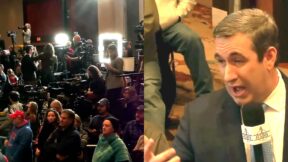GLAAD President Calls Out WaPo For Shutting Down Twitter Discourse After “Anti-Gay” Column
 It happened fast. The organization I run, the Gay & Lesbian Alliance Against Defamation or GLAAD, posted on Twitter a statement that criticized the Washington Post’s decision to give a noted anti-gay activist an editorial platform in which he calls gay and lesbian youth ‘abnormal’ and ‘self-destructive’:
It happened fast. The organization I run, the Gay & Lesbian Alliance Against Defamation or GLAAD, posted on Twitter a statement that criticized the Washington Post’s decision to give a noted anti-gay activist an editorial platform in which he calls gay and lesbian youth ‘abnormal’ and ‘self-destructive’:
@glaad – “The @WashingtonPost Gives Platform to Anti-Gay Activist http://bit.ly/crX6q5 #LGBT #gay”
The straightforward post—or “tweet” in the lingo of the medium—intended to direct people to our blog post, but also to share it with their networks through “retweeting.”
Then, someone who manages social media at the Washington Post did something unusual for newspapers. They tweeted back:
@washingtonpost – “Hi @glaad, we’re working to cover both sides. Earlier, we hosted Dan Savage of It Gets Better in a live chat. http://wapo.st/aA8SXX”
Of course, these tweets are visible to everyone who follows either GLAAD or the Washington Post on Twitter. Tens of thousands of people were privy to this conversation. Judging by the pickup the story started to get in social media, many were clearly engaging in a way they hadn’t before the Post tweeted.
GLAAD responded soon with the following post:
@glaad – “.@WashingtonPost There are not “both sides” to this issue. Teen suicide isn’t a debate-it’s a tragedy. http://bit.ly/crX6q5 #LGBT”
Then it was over. No more Post responses, just an agreement by phone to run an op-ed from GLAAD.
Not too long after this brief Twitter conversation, the newspaper’s management concluded this sort of back-and-forth was unseemly. In a memo to his newsroom staff issued on October 15, 2010, managing editor Raju Narisetti issued a new rule that prohibited news team members from tweeting back. Narisetti explained, in pertinent part:
The intent in replying was to defend the decision to publish the piece, but it was misguided both in describing our rationale for publishing the piece and as a matter of practice. It shouldn’t have been sent.
Even as we encourage everyone in the newsroom to embrace social media and relevant tools, it is absolutely vital to remember that the purpose of these Post branded accounts is to use them as a platform to promote news, bring in user generated content and increase audience engagement with Post content. No branded Post accounts should be used to answer critics and speak on behalf of the Post…
Some news blogs have praised Narisetti for this act, labeling the Post’s tweet as a mistake. This argument in support of Narisetti can be summed up as “you can’t do journalism in 140 characters, and that real responses to readers should be reserved to the Letters to the Editor page.”
Wow. I guess I understand why the newspaper industry is in so much trouble.
The conceit of Narisetti’s memo is its invocation of editorial standards –an ethical “lingua franca” to journalists. But this simple act, logical as a means of keeping up appearances of objectivity, betrays a profound misunderstanding of the medium (Twitter) and the message (the Post tweet that actually reiterated the standard invoked by Narisetti).
Maybe a reader’s interest would have ended here, casually and fulfilled, were it not for the disastrous state of newspapers today. Circulation is down, charging for online news is slow, revenues hemorrhage, stress among managers is high and morale among news staff is often low. Like many other newspapers, the Post has begun building out a social media presence as an effort to capture readers who use this medium—and not the old-fashioned print editions—to get their news.
So if it is important enough to embrace, why ignore the rules of this new medium?
Put another way, using social media involves more than just adding content, but interacting with the public differently. The Letter to the Editor may work for print editions but doesn’t work on Twitter. Narisetti acknowledges as much in his memo: “the purpose of these Post branded accounts is…to promote news, bring in user generated content and increase audience engagement.” So then why did he ban staff from engaging?
In fact, the Post’s lone Twitter response to GLAAD did exactly what Narisetti professes to want from social media. A response to a reader—in this case, a critic of the Post’s editorial decision to give a platform to an unvarnished hater of gay and lesbian people—via Twitter measurably increased audience engagement. Indeed, not just GLAAD but for the hundreds of others who read and retweeted the content, the response on Twitter was exactly the kind of thing a new media savvy corporation would do to attract eyeballs to their content. And instead of praising such engagement, the Post banned it.
Shutting down the lightning fast world of Twitter in this fashion does not portend good things for a dying newspaper industry. And that is why, for those of us who pray there will always be newspapers to wake up to in the morning, Narisetti’s mandate is so sad.
This is an opinion piece. The views expressed in this article are those of just the author.




